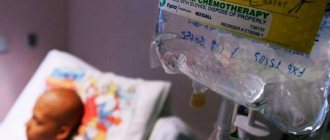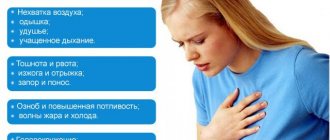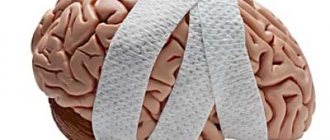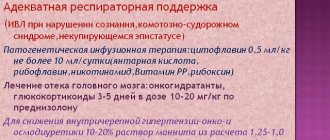Concussion: Symptoms and Signs of Injury
It is important to understand that such an injury can be obtained even as a result of a weak blow to the head, upper part of the neck, or with a sharp shake of the head.
Symptoms of a concussion are very often latent, that is, they do not appear too noticeably, and that is why people often do not even suspect that they have received such an injury, especially if it is a mild form.
So, among the most common signs of a concussion are the following:
- Dizziness. Dizziness can be mild, barely noticeable, severe or moderate. There may be constant dizziness, for example, for 10-15 minutes. or short-term - a second, but constantly repeated.
- Nausea and vomiting. You may feel sick for quite a long time, and you will also experience the urge to vomit, but the vomiting itself, as a rule, happens once.
- Headache. This problem can accompany a concussion until the injury is completely healed; as a rule, the pain is pulsating.
Symptoms
- Stars, flies, a mesh in front of the eyes.
- Weakness. Almost all ailments and concussions, including those accompanied by fatigue, weakness, and irritability.
- Sometimes a concussion can manifest itself as double vision and pain in the eyes.
- Short-term memory loss. Sometimes after a concussion, a person may not remember the events of the few minutes before the injury occurred.
- may also be impaired. When you try to get out of bed and walk straight, you will feel staggering and dizzy.
In young children, signs of a concussion may include:
- Excessive sleepiness. The child may sleep more often and longer than usual.
- Slowness of movements and reactions. The baby may not immediately pay attention to sounds, movements, etc.
- Excessive moodiness, tearfulness and fatigue.
- Changes in gait or inability to walk at all.
- Refusal to eat or decreased appetite, vomiting after eating.
- Pallor of the skin.
- Lack of desire to play with favorite toys, etc.
It often happens in children.
It is necessary to take into account that it is necessary to evaluate the symptoms in a complex manner, since dizziness and nausea can be caused by ordinary poisoning, a child’s tearfulness and refusal to eat can be triggered by fatigue and heat, etc.
We also note that there are 3 degrees of severity of the injury:
- Mild degree. In this case, no special symptoms will be observed. The patient may complain of pain and dizziness, nausea, and increased temperature (37-38°C). As a rule, such signs of injury disappear after half an hour or an hour.
- Average degree. The person is conscious, but at the same time feels severe nausea and vomits, usually once. Also, the course of the disease is accompanied by headaches and impaired coordination. Symptoms may be present from several hours to several days.
Several degrees
- Severe degree. To conclude that an injury is severe, symptoms such as loss of consciousness and temporary memory loss must be present. All of the above symptoms will accompany the patient for several weeks and may further remind of the injury.
○ The severity of beatings according to the law.
I note that the severity of the beating is determined as part of the pre-investigation check based on the conclusion issued by forensic experts .
To determine the degree of severity, it is not enough to simply remove the beatings; it is necessary to obtain an appropriate expert opinion.
In the practice of forensic medical examination and according to the norms of criminal law, there are 3 degrees of harm to health:
1) A mild degree does not cause permanent disability or short-term discomfort;
2) Moderate health harm entails a long-term illness, health disorder, or disruption of the functioning of a body system or organ for a period of 21 days or more. Such harm can also be characterized by a significant permanent loss of general ability to work;
3) Serious harm to health is caused by injury to the skull, brain contusions, and fractures, both open and closed.
Once again, I would like to draw your attention to the fact that the degree of harm caused can only be established as a result of a forensic medical examination. A traumatologist, surgeon, emergency room paramedic and other ordinary doctors cannot determine the degree of harm caused by beatings.
Concussion: causes of injury and risk factors
It is logical to assume that such an injury can be caused by physical impact on a person’s head. However, it is important to know what exactly can cause a concussion , and which people are at risk.
- Our brain is located inside the skull, it is surrounded by 3 meninges, between which cerebrospinal fluid circulates. It is this liquid that plays the role of a kind of shock absorber and protects the brain in the event of an impact.
- If the blow is not very strong, the brain does not hit the hard shells, but if the blow is strong enough, the cerebrospinal fluid will not cope and the brain will be injured.
- A concussion can be caused by a blow to the head and upper neck, a fall, hitting the head on a hard object, or sudden shaking of the head.
Comes from a blow
- The most susceptible to concussions are young children who are learning to walk, since their coordination of movements is not yet adequately developed, and older people, who, due to their age, can also stumble or fall due to dizziness or loss of consciousness. Also at risk are people who have previously had any head injuries, since they are usually accompanied by dizziness even after a long time.
Qualifying features
Qualifying criteria include aggravating conditions of the crime. The corpus delicti necessarily takes into account the premeditation of the action, the number of participants and the motive.
The qualifying signs of causing grievous harm to health in accordance with Article 111, Part 2 and Part 3 include:
- An act against a person in the performance of official duties.
- A crime with special torment and bullying.
- If the actions were performed on a person in a helpless state.
- It was done with danger to society and carrying great destructive power.
- Performed for hire.
- Had antisocial motives.
- Committed by a group – refers to the category of particularly aggravating circumstances.
- Caused death by negligence.
According to this article, a crime that occurs without the above listed qualifying features is punishable by imprisonment for 8 years. In the presence of aggravating circumstances, the court provides for liability for up to 12 years.
According to the last point, when the act entailed death through negligence, two motives are regarded - intentionality of causing harm and subsequent death. For this offense, the offender faces up to 15 years in prison.
With regard to the qualifying characteristics under Article 112 “Intentionally causing harm to health of moderate severity”, the same circumstances are considered as for Art. 111. Exceptions include clauses on execution for hire, creating a public danger and causing death by negligence. A crime without qualifying characteristics is subject to liability - imprisonment for up to 3 years or forced correctional labor for up to 3 years.
In aggravating circumstances under Art. 112 according to part 2 is punishable by arrest for up to 5 years.
Concussion: Diagnosis of Injury
In addition to the symptoms described above, a concussion can be diagnosed in another way. In general, it is worth analyzing the whole picture, that is, the patient’s complaints (description of symptoms) and visible signs.
- Ask the injured person to move their eyes from side to side. Pain and pressure in the eyes when they move are signs of injury.
Diagnostics
- By assessing the condition of the pupils immediately after injury, you can also determine whether there is a concussion. The reaction of the pupils can be different: they can narrow or dilate.
- Twitching pupils. Ask the person to look at the object in your hands. Move the object to the side and stop your hand; if the pupils twitch back a little at the same time, there is most likely a concussion.
- Ask the person to take the following position: let him stand on his feet, which he puts together, let him stretch his arms in front of him, and close his eyes. In the absence of injury, a person will take a similar position without problems, but if there is an injury, it will be difficult to do this due to the inability to stand straight without staggering.
How to stop beatings and bring the offender to justice?
The sooner you contact a forensic expert, the easier it will be for specialists to establish the fact of harm. This can be done even before writing the application.
You can contact both specialized authorities - a forensic medical examination, and a hospital, having received a certificate from a traumatologist or neurologist.
If you write a statement about beating, then an examination will be ordered by law enforcement agencies.
What to do when contacting the police:
- How to stop beatings and bring the offender to justice? Write a statement with a detailed description of the crime, the characters involved, the methods of inflicting pain and the locations of the blows.
- Examination by an expert in the direction of the police, followed by a conclusion on the severity level.
If you decide to identify harm yourself, then you should adhere to the following algorithm:
- Visiting a clinic, hospital, or emergency room. There, a certificate is issued with the diagnosis upon application, the nature of the injuries and the time of admission to the medical facility.
- With all the documents, go to the police to write a statement.
- Repeated examination with the participation of forensic doctors.
The last point is not always fulfilled, since the investigation may only need documents from the hospital.
Concussion: how to provide first aid?
Timely first aid for a concussion is the key to full recovery after injury. It is very important to immediately correctly assess the patient’s condition and, based on this, act further. If a person loses consciousness after an injury, immediately call an ambulance, because such a symptom indicates that the injury is quite dangerous and severe.
Before the ambulance arrives, the patient needs to be provided with so-called first aid. It consists of the following:
- Place the person on the right side in the so-called fetal position, that is, the legs must be bent at the knees and the arms bent at the elbows. The head should be turned to the side; in this position, even in case of vomiting, the person will not choke on the vomit.
- If the injury results in a wound and bleeding comes from it, it is necessary to stop the bleeding. This can be done using a sterile bandage that must be applied to the wound.
- Make sure that the person does not choke on vomit, as vomiting is possible with a concussion.
- Even if the person did not lose consciousness, he must be placed on the bed in the same fetal position.
- At this time, the injured person needs to be provided with complete rest. No music, TV, telephone, etc. Also make sure there is access to fresh air in the room with the patient.
We provide assistance
- It is not advisable to eat or drink before the ambulance arrives, but, as a last resort, you can give the patient plain water; it is still better to abstain from other drinks.
- If an injury occurs during sports, you must immediately stop any activity, training, game, etc. Since even a minimal load at this time can lead to negative consequences and aggravate the patient’s condition.
- Remember that even without obvious signs of a concussion, it is still necessary to see a doctor, as sometimes symptoms of an injury can take several hours or even days to appear.
Why does the brain get damaged?
The consistency of the marrow is between slightly set gelatin and peanut butter, almost like a memory foam pillow.
The brain floats loose inside the skull, which has protrusions and bumps on the inside. The brain is a delicate organ. Any sudden movement with force can cause you to slide back and forth. Such movement can cause temporary and permanent cognitive impairment. Cognitive functions are conscious mental activities - thinking, reasoning, understanding, learning, memory, language, coordination and emotions.
The most vulnerable areas of the brain are the frontal and temporal parts (lobes) due to their anatomy and proximity to the skull. The frontal lobe is responsible for executive functioning, planning, organization, complex thinking, focus and concentration, and emotional self-regulation. The temporal zones are responsible for auditory processing, short-term memory, and mood regulation.
Concussion: treatment
If, after examination, the doctor decides that the patient needs inpatient treatment, he will be hospitalized in a hospital and appropriate treatment will begin. In a hospital, most often only severe concussions are treated, but the decision on hospitalization is still made solely by a specialist.
- The prognosis for such an injury is usually positive. If all the doctor’s instructions and recommendations are followed, the patient’s condition improves quite quickly.
- The most important thing in treating such an injury is rest, enough sleep, and the absence of physical and emotional stress. During treatment, you should not engage in sports, even light physical activity.
- It is also recommended to avoid any work in the first few days after injury. Bed rest should last for at least 3 days, and in case of severe severity, at least 1 week.
Peace is very important
- Treatment of concussions with medications is secondary, but no less important. As a rule, medications help to quickly eliminate symptoms, for example, headaches, fatigue, etc.
- Medicines that are prescribed to people with concussions improve blood circulation, immunity, calm the nervous system, improve sleep, etc.
- If all recommendations are not followed, complications may arise in the form of new ailments or symptoms of a concussion, for example, irritability, drowsiness, etc.
Restrictions from other species
Intentional harm of moderate and severe severity should be distinguished from beatings and torture:
Batterings are most often characterized by inflicting injuries of mild severity. A head injury that occurs as a result of numerous beatings is regarded as severe or moderate harm. Which automatically equates the act to Articles 111 and 112.
- Torture is characterized by the infliction of suffering, both physical and psychological, but the main thing is the systematic infliction of damage to a person. This punishment is considered provided there are no serious consequences for health and loss of performance from parts 2 and 3 of the articles on causing harm.
- Separately, it is worth considering the third part of 111 about the grave consequences of bodily injuries in the head area that resulted in death due to negligence. It is distinguished from murder, since this crime also contains intent, but the accused did not foresee the lethal outcome or believed that the actions would not entail consequences.
Concussion: Injury Prevention
Of course, most often a person receives such an injury not because of his own negligence, but as a result of certain circumstances that do not depend on the person in any way. However, sometimes it is possible to prevent or at least reduce the risk of a concussion, and we are talking about preventive measures.
- When playing sports, use the necessary protective equipment and clothing. Do not ignore this recommendation, wear a helmet and do not violate safety rules, both during sports and during various entertainment, such as cycling, rock climbing, etc.
- When traveling or driving a car, be sure to wear your seat belt. This precaution can save you not only from a concussion, but also from other equally dangerous injuries.
Buckle up
- Put things in their place in your home. Statistics show that most of these injuries occur due to poor lighting and, as a result, due to falls.
- Monitor the safety of your children, especially if we are talking about small children. Do not allow yourself to walk up the stairs; watch your child ride on a swing, slide, etc.
Getting a head injury in the form of a concussion is quite simple, which is why you need to take your own safety as seriously as possible and try to be as careful as possible during sports, active games, etc.
○ What to do if you were beaten?
Current legislation establishes that this crime is a crime of private prosecution , that is, it can only be initiated at the request of the victim and will be proven by him in court. But this does not mean that the victim will be left to the mercy of fate.
If you have become a victim of a beating, the first thing you need to do is contact the police with a statement in which you need to set out all the circumstances of the incident, accurately describe the blows and the place where they were applied, the violent actions that caused pain. You should not hide anything, just as you should not fantasize - the more accurately the facts are presented, the more accurately and quickly the criminal will be punished.
After the victim contacts the police, and such an appeal is mandatory from the point of view of the procedure for collecting and recording evidence in the case, the police will conduct a pre-investigation check , during which the parties to the conflict and witnesses will be interviewed.
The most important thing is that the victim will be given a referral to undergo a forensic medical examination, the conclusion of which confirms the fact of causing physical harm.
It is, of course, better to undergo an examination by a doctor before receiving such a referral, preferably immediately after the beating. This will guarantee the recording of the fact of causing bodily harm - the main subject of proof, and, as a consequence, the punishment of the offender.
Further, based on the results of the audit, the case will be sent to court or closed for lack of corpus delicti.
If you have any questions, I’d be glad to hear them in the comments!
Published by: Vadim Kalyuzhny , specialist of the TopYurist.RU portal
Complications of severe head injury
Severe brain contusion can cause encephalopathy. The motor skills of the legs are impaired, manifested in some dissociation of coordinated movements. If the disease is not treated, patients experience such phenomena.
- Confusion and retardation, poor speech, changes in behavior.
- There are episodes of mental imbalance and aggressive behavior (patients later regret them).
- Increased sensitivity to alcohol and infectious pathologies. Moreover, as a result of drinking alcohol, patients develop delirium.
- Convulsive attacks.
- Sharp headache.
- Psychoses and hallucinations rarely occur.
- In rare cases, patients develop dementia, lack of orientation and impaired judgment.
In 1 case out of 10, a serious brain contusion contributes to post-concussion syndrome. It manifests itself in severe pain, insomnia, and attention disorders. This syndrome is difficult to treat.
A concussion is a serious injury that causes temporary disruption of brain function. If you do not adhere to bed rest, the patient may develop impairments in the ability to remember and maintain attention. A decrease in intelligence is also possible. Early diagnosis and early therapy helps to get rid of the dangerous consequences of the disease.
Recommendations for experts on conducting assessment activities
If there is a need to differentiate (establish) the genesis of the found problem of TBI and symptoms, long-term consequences of other similar injuries or diseases of the central nervous system, in addition to a comprehensive differentiated diagnosis of the materials of the criminal case, as well as the results of examination of the victim by experts, it is necessary to evaluate:
- a complex of clinical and morphological manifestations of TBI with an assessment of the location and direction of the traumatic impact;
- ergometric parameters of traumatic actions, which are interpreted as a manifestation of the analyzed TBI.
If the specified distinctions cannot be made, this is necessarily reflected in the expert opinion.
Let's consider an algorithm for assessing the severity of harm to health in cases of concussion, as well as in other TBIs. What do you need to know in order to correctly assess the patient’s health status?
Let’s say that a patient has a concussion as a result of a traffic accident. What is the severity of the damage to health? The assessment of harm caused by TBI is complex and commission-based. An expert group is being created, which includes a neurosurgeon and neuropathologist. In case of psychopathological manifestations of trauma, a psychiatrist is invited to the expert commission for examination.
If a patient is diagnosed with a concussion, the severity of the harm to health is determined by an expert group of medical professionals. Problems with neurons in TBI are explained by damage to the temporal and frontal lobes of the brain, damage to the white matter of the cerebral hemispheres.









